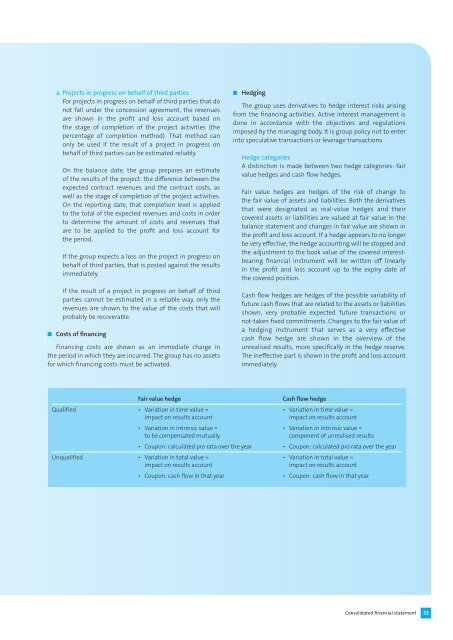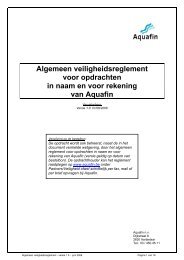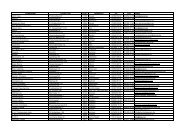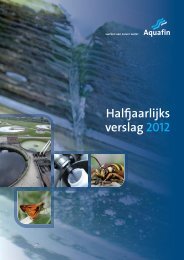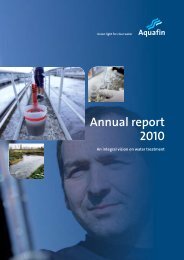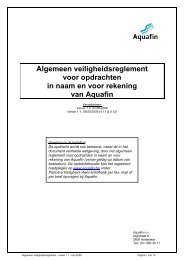Consolidated financial statement 2011 - Aquafin
Consolidated financial statement 2011 - Aquafin
Consolidated financial statement 2011 - Aquafin
Create successful ePaper yourself
Turn your PDF publications into a flip-book with our unique Google optimized e-Paper software.
n<br />
a. Projects in progress on behalf of third parties<br />
For projects in progress on behalf of third parties that do<br />
not fall under the concession agreement, the revenues<br />
are shown in the profit and loss account based on<br />
the stage of completion of the project activities (the<br />
percentage of completion method). That method can<br />
only be used if the result of a project in progress on<br />
behalf of third parties can be estimated reliably.<br />
On the balance date, the group prepares an estimate<br />
of the results of the project: the difference between the<br />
expected contract revenues and the contract costs, as<br />
well as the stage of completion of the project activities.<br />
On the reporting date, that completion level is applied<br />
to the total of the expected revenues and costs in order<br />
to determine the amount of costs and revenues that<br />
are to be applied to the profit and loss account for<br />
the period.<br />
If the group expects a loss on the project in progress on<br />
behalf of third parties, that is posted against the results<br />
immediately.<br />
If the result of a project in progress on behalf of third<br />
parties cannot be estimated in a reliable way, only the<br />
revenues are shown to the value of the costs that will<br />
probably be recoverable.<br />
Costs of financing<br />
Financing costs are shown as an immediate charge in<br />
the period in which they are incurred. The group has no assets<br />
for which financing costs must be activated.<br />
n<br />
Hedging<br />
The group uses derivatives to hedge interest risks arising<br />
from the financing activities. Active interest management is<br />
done in accordance with the objectives and regulations<br />
imposed by the managing body. It is group policy not to enter<br />
into speculative transactions or leverage transactions.<br />
Hedge categories<br />
A distinction is made between two hedge categories: fair<br />
value hedges and cash flow hedges.<br />
Fair value hedges are hedges of the risk of change to<br />
the fair value of assets and liabilities. Both the derivatives<br />
that were designated as real-value hedges and their<br />
covered assets or liabilities are valued at fair value in the<br />
balance <strong>statement</strong> and changes in fair value are shown in<br />
the profit and loss account. If a hedge appears to no longer<br />
be very effective, the hedge accounting will be stopped and<br />
the adjustment to the book value of the covered interestbearing<br />
<strong>financial</strong> instrument will be written off linearly<br />
in the profit and loss account up to the expiry date of<br />
the covered position.<br />
Cash flow hedges are hedges of the possible variability of<br />
future cash flows that are related to the assets or liabilities<br />
shown, very probable expected future transactions or<br />
not-taken fixed commitments. Changes to the fair value of<br />
a hedging instrument that serves as a very effective<br />
cash flow hedge are shown in the overview of the<br />
unrealised results, more specifically in the hedge reserve.<br />
The ineffective part is shown in the profit and loss account<br />
immediately.<br />
Fair value hedge<br />
Cash flow hedge<br />
Qualified • Variation in time value = • Variation in time value =<br />
impact on results account<br />
impact on results account<br />
• Variation in intrinsic value = • Variation in intrinsic value =<br />
to be compensated mutually<br />
component of unrealised results<br />
• Coupon: calculated pro rata over the year<br />
• Coupon: calculated pro rata over the year<br />
Unqualified • Variation in total value = • Variation in total value =<br />
impact on results account<br />
impact on results account<br />
• Coupon: cash flow in that year<br />
• Coupon: cash flow in that year<br />
<strong>Consolidated</strong> <strong>financial</strong> <strong>statement</strong><br />
33


